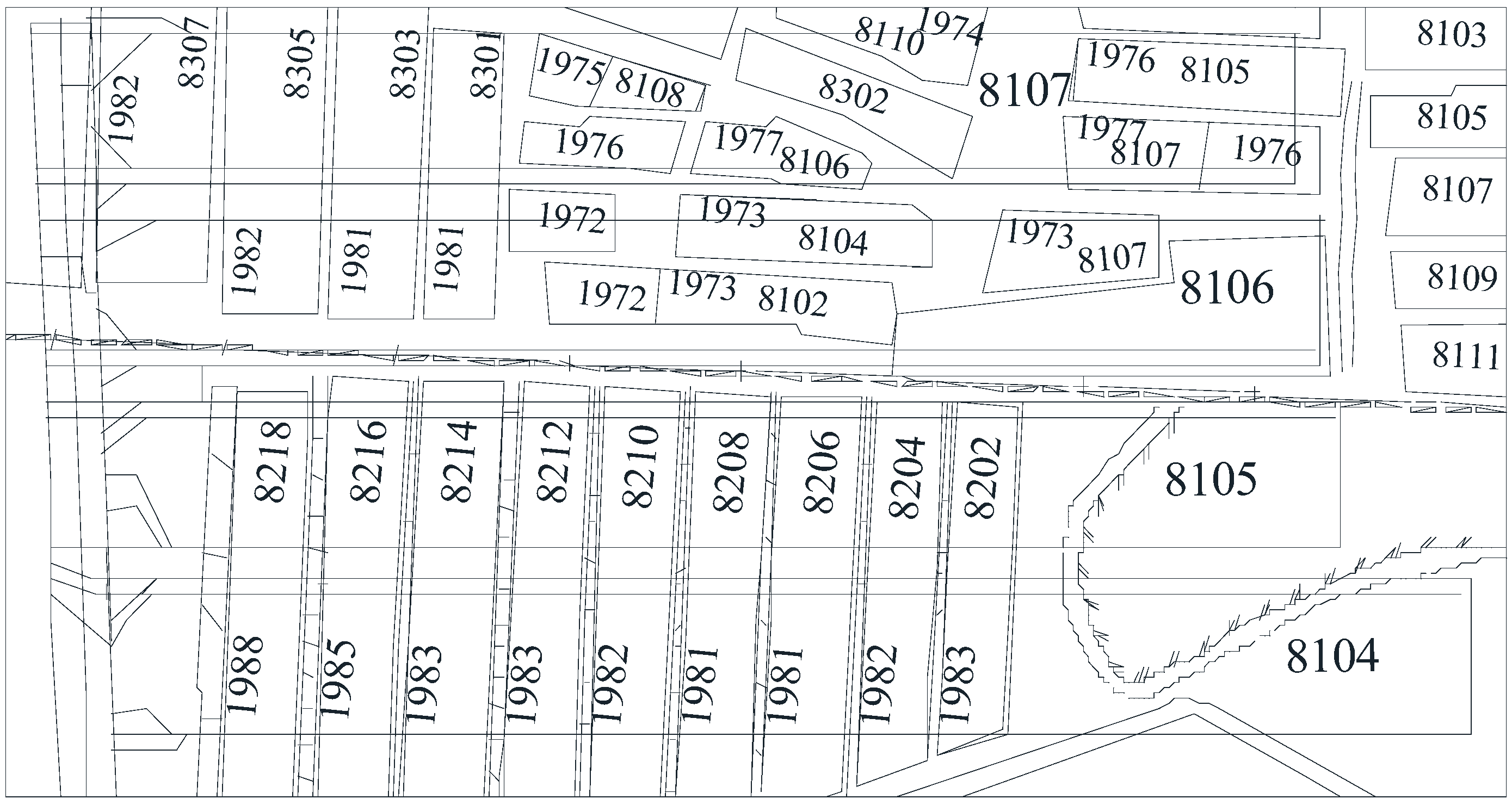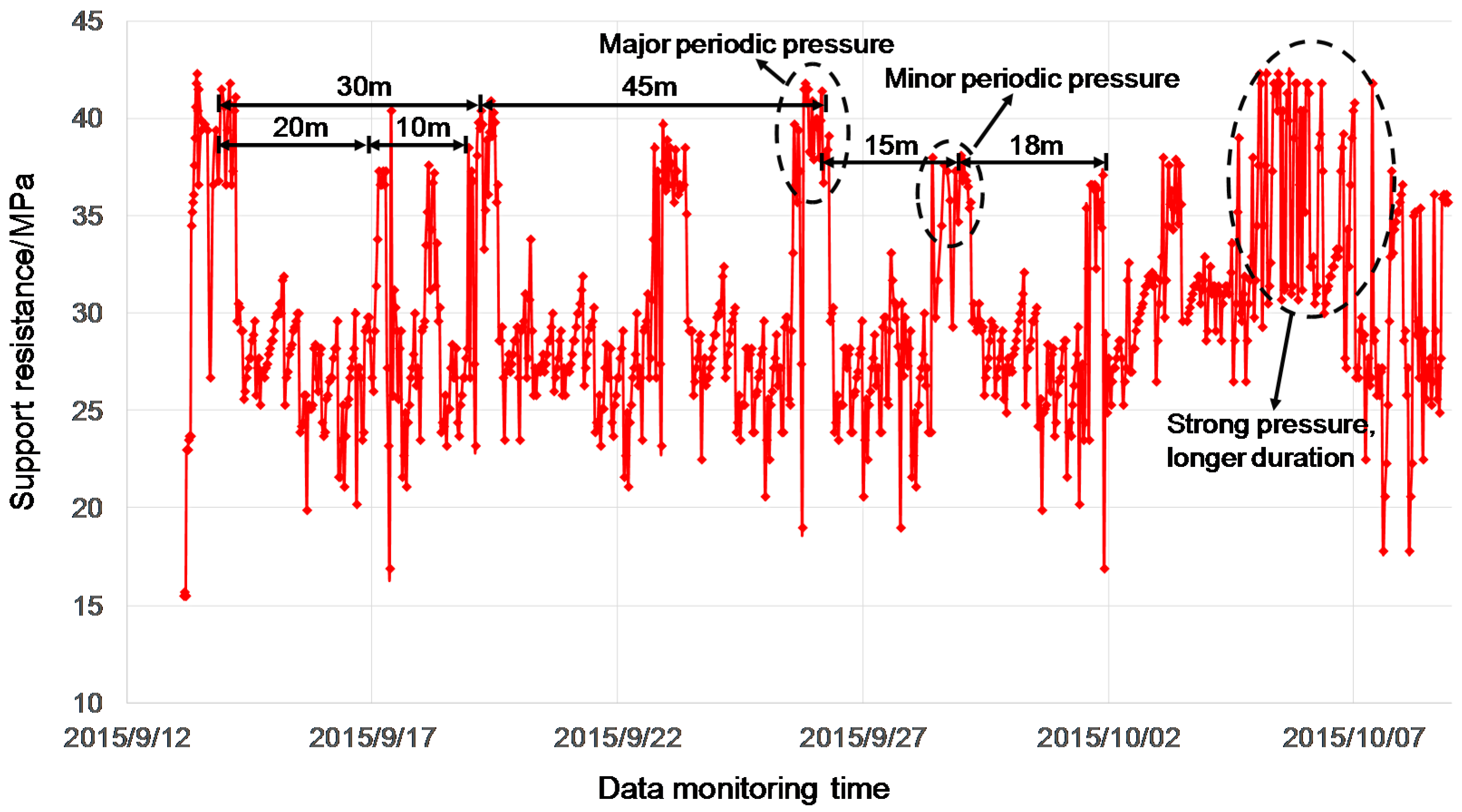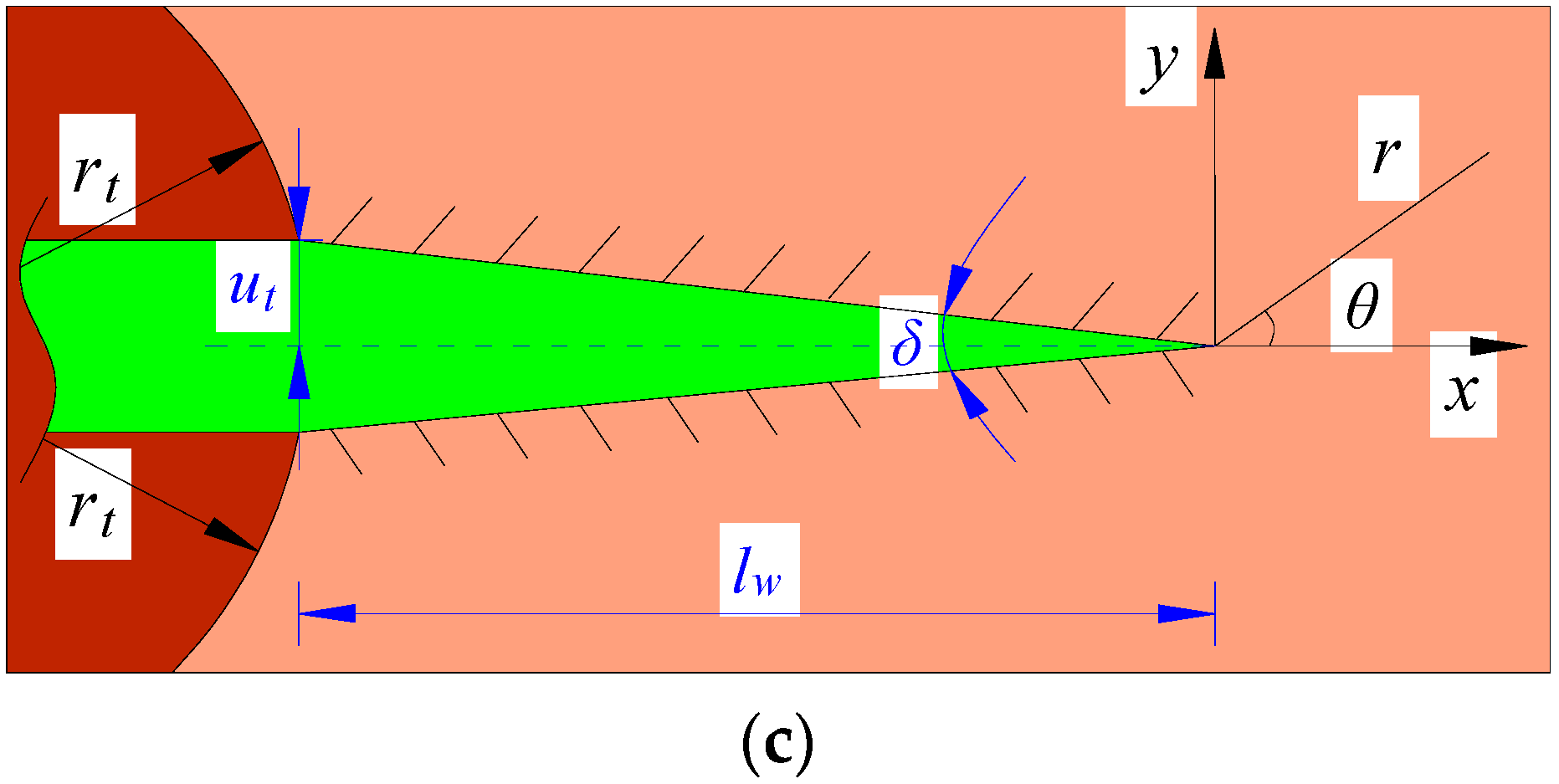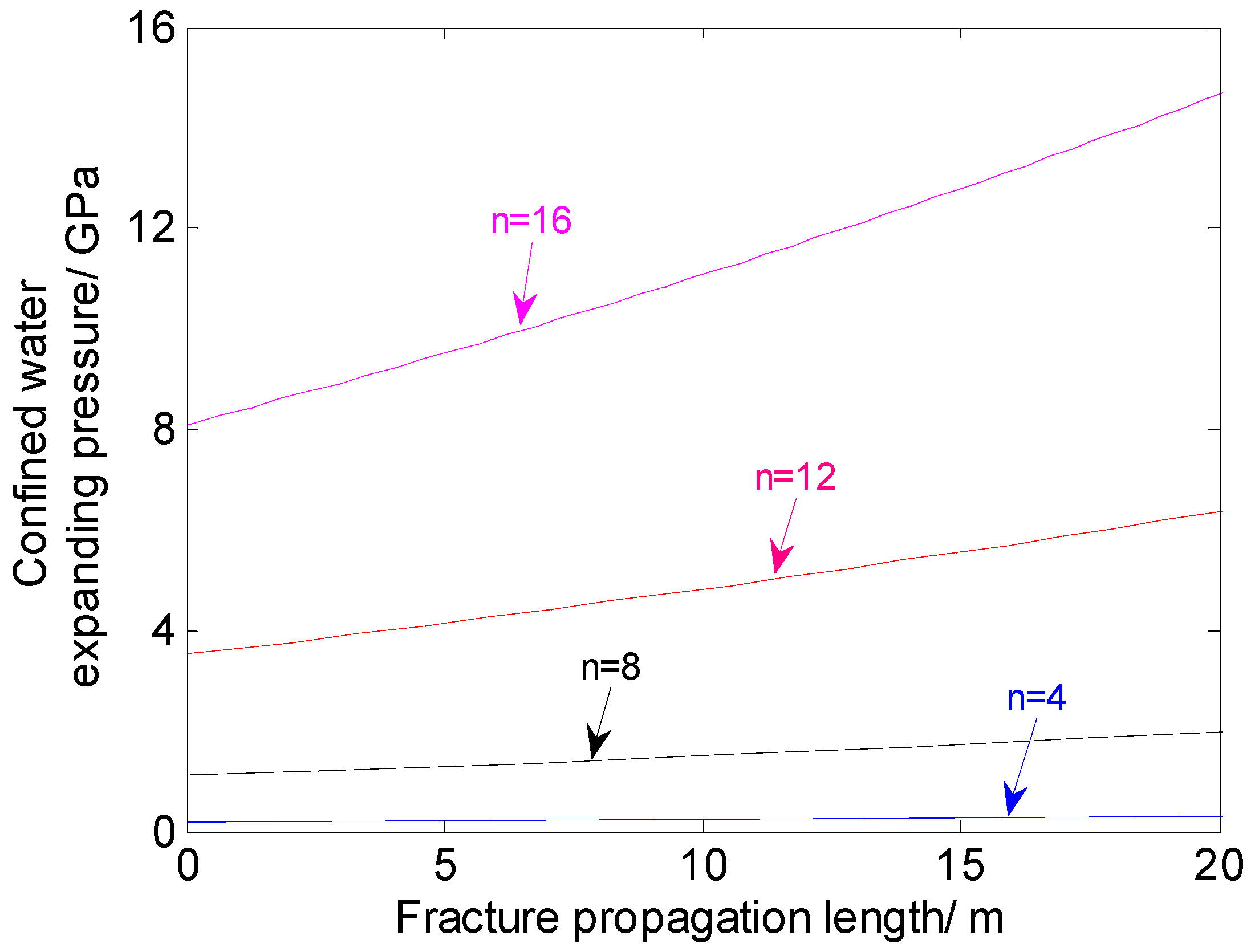Application of Confined Blasting in Water-Filled Deep Holes to Control Strong Rock Pressure in Hard Rock Mines
Abstract
:1. Introduction
2. Overview of Mining in Datong Coal Mine Area
3. Mechanism of Roof Control by Blasting
4. Practical Application of the Blasting Technique
4.1. Implementation of Blasting and Parameter Determination
- (1)
- This technique uses confined water as a transmission medium for detonation waves. The purpose is to prevent water leakage, force air out of pores and fractures in the surrounding rock, and take advantage of water’s ability to transfer energy efficiently. Driven by the great explosive energy, the water can penetrate into the surrounding rock like a wedge and create fractures. Before detonation, the water in the holes should be pressurized using an appropriate measure in order to enhance the results of blasting. Based on the characteristics of the pipe network in the blast roadway, the design pressure of the confined water was determined to be 2.0 MPa.
- (2)
- Research showed that the tensile fracture zone created by blasting in a water-filled hole had a radius 10–15 times that of the blast-hole diameter [13,15]. When the blast-hole diameter was 60 mm, the tensile fracture zone in the surrounding rock had a radius of 0.33–0.49 m. The fractures surrounding pilot holes were about 0.13 m long. After the expanding confined water wedged into fractures in the surrounding rock, the water-bearing fractures would propagate at least 5.0 m [13]. These suggest that the minimum spacing between blast holes and pilot holes in hard roof should be about 5.5 m. Given the high efficiency of energy use during confined blasting in water-filled deep holes, the spacing between blast holes was increased to 7.0 m in practical application for the purpose of avoiding mutual interference between strong dynamic loads from adjacent holes.
- (3)
- Determining the amount of explosive needed is an important task in designing a blasting plan, as the amount of explosive used has a direct bearing on the results and cost of blasting. The most common method is to calculate the mass of explosive according to volume. Considering that the sandstones in the roof are quite hard, the explosive consumption coefficient per unit volume was set at 1.2 for Class 3 emulsion explosives permitted for use in coal mines. Then the mass of explosive required to create an effective damage zone around a single hole was estimated to be 106.7 kg. Given the high efficiency of explosive energy use in the presence of water, it is reasonable to multiply this amount by a proper reduction factor to calculate the amount of explosive for the technique proposed. In this case, a reduction factor of 0.3 [13] was adopted and the amount of explosive for a single hole was estimated to be 32 kg.
4.2. Main Blasting Operations
- (1)
- The explosive material adopted in this study was a Class 3 emulsion explosive permitted for use in coal mines. The explosive charges were connected by a type of detonating cords for use in mines and detonated by an instantaneous electrical detonator, which was initiated using a trigger. Before loading, a tamping bar was used to clean coal and rock powder off the holes. Then the actual depths of the holes were measured and recorded. Then explosive charges were put into the blast holes properly with the help of a fixture, and the detonating cords were taken out of the holes along the hole wall in sequence.
- (2)
- A sealing device fixed with an injection pipe and an outlet pipe was used to seal the holes. The seal length was 1/3 of the depth of each hole. The outlet pipe extended to the bottom of each hole and had a strainer at this end to prevent blockage. The injection pipes were longer than the sealing device.
- (3)
- After that, the detonating cords from different holes were connected and the pipe network for delivering confined water was established. Then the valves on the injection pipes were opened and the valves on the outlet pipes were opened slightly so that the injected water could drive the air out of the holes. Each injection pipe was provided with a check valve to prevent back-flow of the confined water. Figure 13 shows the profile of a water-filled blast hole.
- ◆
- During water injection, the valve on each outlet pipe was open until the pressure gauge installed on the outlet pipe indicated a steady increase in pressure. As the water pressure in the holes reached 2 MPa, the valve on the injection pipes were closed. The seals on the holes were rechecked to ensure that the confined water in the holes could not get out. Once a pressure decline was observed in a hole, the valve on the corresponding injection pipe was opened slightly for pressurization.
- ◆
- Initiation was done outside the air door of the blast roadway and all personnel must leave the blast roadway before initiation.
4.3. Effectiveness of Blasting in Roof Control
5. Conclusions
- (1)
- Mining in thick and extra-thick coal seams can cause large-scale disturbance to overburden. The roof strata in the disturbed region show structural evolution in succession during mining and ultimately form a complex structure. Destabilization of the upper stratais the main factor driving strong strata behavior.
- (2)
- The intensity of the shock wave caused by the detonation wave in the medium increases in an approximately linear manner with the increase in the initial density of the medium. By properly increasing the pressure of the detonation-transferring medium in the drill hole, a full solid-liquid coupling can be achieved. This will enhance the rock-breaking capacity of the detonation wave on the surrounding rocks.
- (3)
- The confined water in the drill hole is wedged into the wave-induced cracks under the expansion and squeezing of the detonation products. The dynamic and static loads of water medium work in combination along the dynamic pressure transfer pathway, which facilitates crack propagation in the surrounding rocks.
- (4)
- The mechanical model describing the process of water medium wedging into the cracks and promoting crack growth in the surrounding rocks during detonation. Under a fixed number of cracks, the ultimate length of the cracks increases with the expansion pressure of the water medium. The greater the number of the cracks, the lower the variation rate of the initial expansion pressure of the water medium is.
- (5)
- The incompressibility of water is utilized. The dynamic pressure transfer capacity of the confined water is combined with the expansion and squeezing of the water after blasting to promote crack propagation. This is the root cause of high efficiency presplit blasting using the technique in coal rocks.
- (6)
- A plan for implementing confined blasting to presplit hard coal and rock was designed during thick seam mining in the Datong Coal Mine area, and a comparative analysis suggests that theconfined blasting technique caused in significant damage to the coal and rock with less explosive consumption and a substantial reduction in rock pressure.
Acknowledgments
Author Contributions
Conflicts of Interest
References
- Yu, B. Study on Strong Pressure Behavior Mechanism and Roof Control of Fully Mechanized Top Coal Caving in Extra Thickness Seam in Datong Coal Mine. Ph.D. Thesis, China University of Mining and Technology, Xuzhou, China, 2014. [Google Scholar]
- Yang, J.X.; Liu, C.Y.; Yu, B.; Liu, J.R. Impact effect caused by the fracture of thick and hard roof structures in a longwall face. J. China Univ. Min. Technol. 2014, 43, 8–15. [Google Scholar]
- Yu, B.; Zhao, J.; Kuang, T.J.; Meng, X.B. In situ investigations into overburden failures of a super-thick coal seam for longwall top coal caving. Int. J. Rock Mech. Min. Sci. 2015, 78, 155–162. [Google Scholar] [CrossRef]
- Yang, J.X.; Liu, C.Y.; Yu, B.; Wu, F.F. The effect of a multi-gob pier-type roof structure on coal pillar load-bearing capacity and stress distribution. Bull. Eng. Geol. Environ. 2015, 74, 1267–1273. [Google Scholar] [CrossRef]
- Verma, H.K.; Samadhiya, N.K.; Singh, M.; Goel, R.K.; Singh, P.K. Blast induced rock mass damage around tunnels. Tunn. Undergr. Space Technol. 2018, 71, 149–158. [Google Scholar] [CrossRef]
- Marko, B.; Celso, R.; Deane, R. Finite element analysis of blast-induced fracture propagation in hard rocks. Comput. Struct. 2017, 182, 1–13. [Google Scholar]
- Singh, P.K.; Roy, M.P.; Paswan, R.K.; Sarim, M.D.; Kumar, S.; Jha, R.R. Rock fragmentation control in opencast blasting. J. Rock Mech. Geotech. Eng. 2016, 8, 225–237. [Google Scholar] [CrossRef]
- Piyush, R.; Hakan, S.; Per-Arne, L.; Uday, K. Measurement-while-drilling technique and its scope in design and prediction of rock blasting. Int. J. Min. Sci. Technol. 2016, 26, 711–719. [Google Scholar]
- Wang, Y.B. Study of the dynamic fracture effect using slotted cartridge decoupling charge blasting. Int. J. Rock Mech. Min. Sci. 2017, 96, 34–46. [Google Scholar] [CrossRef]
- Ramezanzadeh, A.; Hood, M. A state-of-the-art review of mechanical rock excavation technologies. Int. J. Min. Environ. Issues 2010, 1, 29–39. [Google Scholar]
- Wu, W.Y.; Li, J.X. Experimental study and application on control blasting with water coupled charge in tunneling. Nonferrous Met. 2003, 5, 20–21. [Google Scholar]
- Ming, F.; Zhu, W.H.; Li, Q.D. Application of water-couple charge blasting in tunnel excavation. Chin. J. Undergr. Space Eng. 2012, 8, 1008–1013. [Google Scholar]
- Yang, J.X. Study on Confined Blasting Control Mechanism of Hard Coal Rock with High Safety and Efficiency and Test Analysis. Ph.D. Thesis, China University of Mining and Technology, Xuzhou, China, 2015. [Google Scholar]
- Wang, W.; Li, X.C.; Shi, L.; Fang, Z.M. Discussion on decoupled charge loosening blasting in deep rock mass. Rock Soild Mech. 2008, 29, 2837–2842. [Google Scholar]
- Zong, Q.; Luo, Q. Experimental study on distribution character of blasting stress when boreholes with water couple charge. J. Exp. Mech. 2006, 21, 393–398. [Google Scholar]
- Yan, S.L.; Xu, Y. Numerical simulation of water-coupled charge rock blasting mechanism. Chin. J. Undergr. Space Eng. 2005, 1, 921–924. [Google Scholar]
- Anderson, C.E.; Behner, T.; Weiss, C.E. Mine blast loading experiments. Int. J. Impact Eng. 2011, 38, 697–706. [Google Scholar] [CrossRef]
- Jin, Z.Y.; Yin, C.Y.; Chen, Y.; Hua, H.X. One-dimensional analytical model for the response of elastic coatings to water blast. J. Fluids Struct. 2015, 59, 37–56. [Google Scholar] [CrossRef]
- Boteler, J.M.; Sutherland, G.T. Tensile failure of water due to shock wave interactions. J. Appl. Phys. 2004, 96, 6919–6924. [Google Scholar] [CrossRef]
- Deshpande, V.S.; Fleck, N.A. One-dimensional response of sandwich plates to under water shock loading. J. Mech. Phys. Solids 2005, 53, 2347–2383. [Google Scholar] [CrossRef]
- Pereira, J.M.; Campos, J.; Lourenco, P.B. Masonry infill walls under blast loading using confined underwater blast wave generators. Eng. Struct. 2015, 92, 69–83. [Google Scholar] [CrossRef] [Green Version]
- Cho, S.H.; Nakamura, Y.; Kaneko, K. Dynamic fracture process analysis of rock subjected to stress wave and gas pressurization. Int. J. Rock Mech. Min. Sci. 2004, 41, 433–440. [Google Scholar] [CrossRef]
- Goodarzi, M.; Mohammadi, S.; Jafari, A. Numerical analysis of rock fracturingby gas pressure using the extended finite element method. Pet. Sci. 2015, 12, 304–315. [Google Scholar] [CrossRef]
- Donze, F.V.; Bouchez, J.; Magnier, S.A. Molding fractures in rockblasting. Int. J. Rock Mech. Min. Sci. 1997, 34, 1153–1163. [Google Scholar]
- Edri, I.; Savir, Z.; Feldgun, V.R.; Karinski, Y.S.; Yankelevsky, D.Z. On blast pressure analysis due to a partially confined explosion: I. Experimental studies. Int. J. Prot. Struct. 2011, 2, 1–20. [Google Scholar] [CrossRef]
- Li, X.B. Rock Drilling and Blasting Engineering; Central South University Press: Changsha, China, 2011. [Google Scholar]
- Dai, J. Dynamic Behaviours and Blasting Theory of Rock; Metallurgical Industry Press: Beijing, China, 2013. [Google Scholar]
- Fan, T.Y. Principle and Application of Fracture Mechanics; Press of Beijing Institute of Technology: Beijing, China, 2006. [Google Scholar]
- Liu, C.Y.; Yang, J.X.; Yu, B. Rock-breaking mechanism and experimental analysis of confined blasting of borehole surrounding rock. Int. J. Min. Sci. Technol. 2017, 27, 795–801. [Google Scholar]















| Angle of Horizontal Rotation (°) | Elevation Angle (°) | Vertical Height (m) | Hole Depth (m) | Seal Length (m) | Length of Charge (m) | Charge Weight (kg) | ||
|---|---|---|---|---|---|---|---|---|
| Conventional Blasting | Confined Blasting | Conventional Blasting | Confined Blasting | |||||
| 20 | 13 | 7.87 | 35 | 12 | 23 | 16 | 46 | 32 |
| 15 | 13 | 7.87 | 35 | 12 | 23 | 16 | 46 | 32 |
| 15 | 9 | 5.48 | 35 | 12 | 23 | 16 | 46 | 32 |
| Support Resistance Category | Location of Measuring Line | Support Resistance (kN) | ||
|---|---|---|---|---|
| Average | Mean Square Error | Maximum | ||
| Support resistance | Head | 5930.7 | 1024.4 | 6791.5 |
| Middle | 7012.1 | 1125.2 | 7386.6 | |
| Tail | 6543.3 | 1432.5 | 7156.7 | |
| Mean | 6495.4 | 1194.0 | 7111.6 | |
| Time-weighted resistance | Head | 6456.3 | 1391.4 | 6978.3 |
| Middle | 6958.4 | 1082.0 | 7220.0 | |
| Tail | 6835.1 | 1380.4 | 7011.0 | |
| Mean | 6749.9 | 1284.6 | 7069.8 | |
© 2017 by the authors. Licensee MDPI, Basel, Switzerland. This article is an open access article distributed under the terms and conditions of the Creative Commons Attribution (CC BY) license (http://creativecommons.org/licenses/by/4.0/).
Share and Cite
Yang, J.; Liu, C.; Yu, B. Application of Confined Blasting in Water-Filled Deep Holes to Control Strong Rock Pressure in Hard Rock Mines. Energies 2017, 10, 1874. https://doi.org/10.3390/en10111874
Yang J, Liu C, Yu B. Application of Confined Blasting in Water-Filled Deep Holes to Control Strong Rock Pressure in Hard Rock Mines. Energies. 2017; 10(11):1874. https://doi.org/10.3390/en10111874
Chicago/Turabian StyleYang, Jingxuan, Changyou Liu, and Bin Yu. 2017. "Application of Confined Blasting in Water-Filled Deep Holes to Control Strong Rock Pressure in Hard Rock Mines" Energies 10, no. 11: 1874. https://doi.org/10.3390/en10111874




